List of local nature reserves in Surrey
Local nature reserves are designated by local authorities under the National Parks and Access to the Countryside Act 1949. The local authority must have a legal control over the site, by owning or leasing it or having an agreement with the owner. Local nature reserves are sites which have a special local interest either biologically or geologically. Local authorities have a duty to care for them, and can apply local bye-laws to manage and protect them.[1][2]
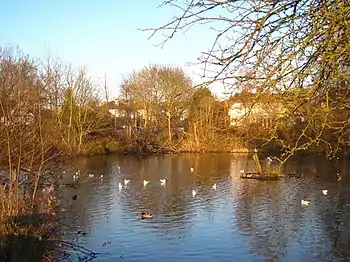
As of January 2019, there are forty-four local nature reserves in Surrey.[3] Fourteen sites are Sites of Special Scientific Interest, five are Special Protection Areas, three are Special Areas of Conservation, one is listed on the Register of Historic Parks and Gardens, one is a Nature Conservation Review site and one is a Geological Conservation Review site. Two sites are scheduled monuments and fourteen are managed by the Surrey Wildlife Trust.
Surrey is a county in South East England. It has an area of 642 square miles (1,660 square kilometres)[4] and an estimated population of 1.1 million as of 2017.[5] It is bordered by Greater London, Kent, East Sussex, West Sussex, Hampshire and Berkshire. Its top level of government is provided by Surrey County Council and the lower level by eleven boroughs and districts, Elmbridge, Epsom and Ewell, Guildford, Mole Valley, Reigate and Banstead, Runnymede, Spelthorne, Surrey Heath, Tandridge, Waverley and Woking.[6]
Other classifications
Sites
| Site | Photograph | Area[lower-alpha 1] | Location[lower-alpha 2] | Borough or District | Other classifications | Map[lower-alpha 3] | Details[lower-alpha 1] | Description |
|---|---|---|---|---|---|---|---|---|
| Ashtead Park |  |
24.2 hectares (60 acres) |
Ashtead 51.313°N 0.291°W TQ 192 585 |
Mole Valley | RHPG,[7] SWT[8] | Map | Details | The nature reserve was formerly part of the park of Ashtead House. It is mainly woodland on heavy London Clay and it has two ponds. Fauna include the broad-bodied chaser and emperor dragonflies and the common blue damselfly.[8] |
| Bisley and West End Commons |  |
37.2 hectares (92 acres) |
West End 51.327°N 0.651°W SU 941 595 |
Surrey Heath | SAC,[9] SPA,[10] SSSI,[11] SWT[12] | Map | Details | This site has heath, grassland and woodland. There are mammals such as roe deer and reptiles include adders, grass snakes, slow-worms and common lizards.[12] |
| Blanchman's Farm | 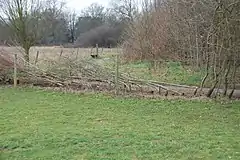 |
9.4 hectares (23 acres) |
Warlingham 51.305°N 0.052°W TQ 359 580 |
Tandridge | Map | Details | This site has woodland, two meadows, a pond and an orchard. There are black hairstreak butterflies and mammals include foxes, roe deer, wood mice.[13] | |
| Blindley Heath |  |
25.8 hectares (64 acres) |
Godstone 51.186°N 0.045°W TQ 367 448 |
Tandridge | SSSI,[14] SWT[15] | Map | Details | This damp grassland site on Weald Clay has a rich flora. There are also a number of ponds and a stretch of the Ray Brook runs through the heath. The grassland is dominated by tussock grass and there are scattered oaks, hawthorns, willows and blackthorns.[16] |
| Brentmoor Heath |  |
28.6 hectares (71 acres) |
West End 51.340°N 0.655°W SU 938 610 |
Surrey Heath | SAC,[9] SPA,[10] SSSI,[11] SWT[17] | Map | Details | The nature reserve has heathland, woodland, acid grassland and ponds. There are grass snakes and adders, and birds such as woodlarks, Dartford warblers, peregrine falcons and hobbies.[17] |
| Centenary Fields | .jpg.webp) |
4.2 hectares (10 acres) |
Lingfield 51.178°N 0.016°W TQ 386 440 |
Tandridge | Map | Details | This site, which is managed by local volunteers, has grassland, a wildflower meadow, allotments and a butterfly garden. A local variety of apple, the Lingfield Forge, is being grown in a community orchard.[18][19] | |
| Chertsey Meads |  |
41.0 hectares (101 acres) |
Chertsey 51.385°N 0.477°W TQ 061 662 |
Runnymede | Map | Details | This is an area of floodplain meadow on the bank of the River Thames. Over 400 plant species have been recorded and 108 bird species, including lesser whitethroat, reed bunting, reed warbler and sedge warbler.[20] | |
| Chinthurst Hill |  |
17.2 hectares (43 acres) |
Guildford 51.203°N 0.553°W TQ 012 459 |
Guildford | SM,[21] SWT[22] | Map | Details | The hill has woodland and dry acid grassland. There are woodland flowering plants such as wood anemone, yellow archangel, wood forget-me-not, red campion, common figwort, butcher’s broom and lady’s smock.[23] |
| Claygate Common |  |
14.1 hectares (35 acres) |
Claygate 51.354°N 0.336°W TQ 160 630 |
Elmbridge | Map | Details | The common is woodland with oak, beech and hornbeam. It has birds such as kestrels, green woodpeckers and sparrowhawks.[24] | |
| Earlswood Common |  |
89.1 hectares (220 acres) |
Redhill 51.223°N 0.181°W TQ 271 487 |
Reigate and Banstead | Map | Details | Habitats on the common include woodland, semi-improved grassland, two large lakes, several ponds and wetland corridors. There are diverse insect species and mammals such as roe deer, foxes, rabbits and bats.[25] | |
| Edolph's Copse |  |
27.6 hectares (68 acres) |
Charlwood 51.167°N 0.235°W TQ 235 423 |
Mole Valley | Map | Details | The copse is mainly secondary woodland but it has areas of ancient forest. The most common trees are oak, hazel and hornbeam, with a few crab apples and hawthorns and a large wild service tree. There are also several ponds and some grassland.[26] | |
| Epsom Common |  |
177.4 hectares (438 acres) |
Epsom 51.328°N 0.292°W TQ 191 602 |
Epsom and Ewell | SSSI[27] | Map | Details | This is a nationally important wildlife site due to its breeding birds and to its insects which depend on dead wood. Other fauna include roe deer, herons and purple emperor butterflies, and there are flora such as common spotted and southern marsh orchids.[28] |
| Esher Common |  |
137.2 hectares (339 acres) |
Esher 51.348°N 0.376°W TQ 132 622 |
Elmbridge | SSSI[29] | Map | Details | More than 2,000 species of invertebrates have been recorded on the common, out of which many are nationally rare or scarece. They include the brilliant emerald dragonfly, small red damselfly and white-letter hairstreak butterfly.[30] |
| Farnham Park |  |
131.0 hectares (324 acres) |
Farnham 51.225°N 0.797°W SU 841 480 |
Waverley | Map | Details | This medieval deer park has an avenue of mature trees which is over a kilometere long. There is grassland, woodland, ponds and streams.[31] | |
| The Flashes |  |
115.1 hectares (284 acres) |
Farnham 51.150°N 0.768°W SU 863 397 |
Waverley | SAC,[9] SPA,[32] SSSI[33] | Map | Details | Most of The Flashes is a river valley mire with purple moor-grass, cross-leaved heath, common cottongrass, heather, rushes and sphagnum mosses. Part of the site is covered with peat.[34] |
| Fox Corner Wildlife Area |  |
6.2 hectares (15 acres) |
Woking 51.282°N 0.624°W SU 961 545 |
Guildford | Map | Details | The wildlife area was created in 1990 following compulsory purchase of the site. It has woods, a wildflower meadow and a pond.[35] There are birds such as the great spotted woodpecker, small tortoiseshell and comma butterflies, while flowering plants include grass vetchling and meadowsweet.[36] | |
| Hackhurst Downs |  |
29.9 hectares (74 acres) |
Gomshall 51.226°N 0.433°W TQ 095 486 |
Guildford | SSSI,[37] SWT[38] | Map | Details | Much of this steeply sloping site is chalk grassland which is grazed by goats, and there are also areas of mature woodland and scrub. Flowering plants include wild marjoram, hedge bedstraw, vervain, harebell and mouse-ear hawkweed.[38] |
| Hill Park, Tatsfield | .jpg.webp) |
24.5 hectares (61 acres) |
Tatsfield 51.284°N 0.039°W TQ 423 559 |
Tandridge | SWT[39] | Map | Details | This site on the slope of the North Downs has flora-rich chalk grassland with fly, bee and pyramidal orchids.[39] There is also woodland with ash, beech, yew and an avenue of horse chestnuts.[40] |
| Hogsmill |  |
36.0 hectares (89 acres) |
Ewell 51.361°N 0.268°W TQ 207 639 |
Epsom and Ewell | Map | Details | This site along the Hogsmill River and its banks has woodland, scrub and open grassy rides. Bird species include firecrests, kingfishers, fieldfares and redwings, while there are butterflies such as red admirals and peacocks.[41] | |
| Horton Country Park |  |
152.3 hectares (376 acres) |
Epsom 51.351°N 0.290°W TQ 192 627 |
Epsom and Ewell | Map | Details | The park has a range of habitats, including ancient woodland, grassland and ponds. There are many butterflies in summer, and other fauna such as green woodpeckers, roe deer and herons.[42] | |
| Inholms Clay Pit | .jpg.webp) |
8.4 hectares (21 acres) |
North Holmwood 51.211°N 0.321°W TQ 174 471 |
Mole Valley | SWT[43] | Map | Details | This former clay quarry has young woodland and open grassland. Flora in the woods include dog's mercury and wood anemone, while the grassland has orchids such as common spotted, pyramidal and southern marsh. Bird species include siskin, buzzard and lapwing.[43] |
| Lakeside Park | 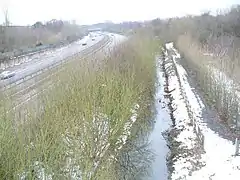 |
14.7 hectares (36 acres) |
Ash 51.258°N 0.729°W SU 888 517 |
Guildford | Map | Details | The Blackwater River runs through this wetland site, which also has ponds, lakes, reed beds, an orchid meadow and wet woodland. Flora include water violet, bee orchid and ragged robin. There are bats, common blue butterflies and hairy dragonflies.[44] | |
| Lingfield Wildlife Area | .jpg.webp) |
6.3 hectares (16 acres) |
Lingfield 51.179°N 0.017°W TQ 387 441 |
Tandridge | Map | Details | This site adjoins Centenary Fields and both are managed by local volunteers. There is a wildlife area, copses, a pond, a wetland area, hedges, meadows and a skateboard ramp.[18][19] | |
| Mayford Meadows | .jpg.webp) |
4.9 hectares (12 acres) |
Woking 51.297°N 0.570°W SU 998 563 |
Woking | Map | Details | Management of these meadows aims to encourage wet grassland with a rich variety of flora. Species of flowering plants include cuckooflower, marsh marigold, purple loosestrife, meadowsweet and yellow water-lily.[45] | |
| Molesey Heath |  |
17.8 hectares (44 acres) |
Molesey 51.392°N 0.374°W TQ 132 671 |
Elmbridge | Map | Details | This site was formerly a gravel pit and then a landfill site. It has been colonised naturally by rough grassland and scrub. Fauna include burrowing bees, wasps and diverse bird species such as little ringed plovers and redshanks.[46] | |
| Nore Hill Pinnacle |  |
0.2 hectares (0.49 acres) |
Warlingham 51.300°N 0.025°W TQ 378 575 |
Tandridge | Map | Details | This very small geological Local Nature Reserve is a Regionally Important Geological Site. It was previously a gravel pit and when the gravel was removed a number of natural chalk pinnacles were discovered. This is the only one which has been retained.[47] | |
| Ockham and Wisley |  |
332.6 hectares (822 acres) |
Wisley 51.317°N 0.456°W TQ 077 587 |
Guildford | SPA,[10] SSSI,[48] SWT[49] | Map | Details | This site is mainly heathland but it also has areas of open water, bog, woodland and scrub. It has a rich flora and it is of national importance for true flies and for dragonflies and damselflies. Rare species include the white-faced darter dragonfly and the Thyridanthrax fenestratus bee fly.[50] |
| Pewley Down |  |
9.5 hectares (23 acres) |
Guildford 51.230°N 0.558°W TQ 008 489 |
Guildford | Map | Details | This chalk grassland site has several species of rare flowering plants, including six orchids. Invertebrates include 26 species of butterflies and 119 of bees, wasps and ants.[51] | |
| Reigate Heath |  |
51.6 hectares (128 acres) |
Reigate 51.237°N 0.231°W TQ 236 501 |
Reigate and Banstead | SM,[52] SSSI[53] | Map | Details | Most of the site is heath and acidic grassland, with some areas of woodland and marshy meadow. One part is a golf course. The heath is mainly ling, bell heather and wavy hair-grass. Marshy meadows have Yorkshire fog, sharp-flowered rush, meadowsweet, wild angelica and marsh marigold.[54] |
| River Mole |  |
23.3 hectares (58 acres) |
Leatherhead 51.292°N 0.338°W TQ 160 561 |
Mole Valley | Map | Details | This site consists of two stretches of the River Mole and its banks, one in Leatherhead and the other north-west of the town. It has very diverse fauna and flora.[55][56] | |
| Riverside Park |  |
61.6 hectares (152 acres) |
Guildford 51.255°N 0.561°W TQ 005 516 |
Guildford | Map | Details | This wetland site has open water and reedbeds. Breeding birds include terns, sedge warblers, reed buntings, water rails, redshanks, snipe and lapwings.[57] | |
| Riverside Walk, Virginia Water |  |
21.2 hectares (52 acres) |
Englefield Green 51.399°N 0.573°W SU 994 676 |
Runnymede | Map | Details | This is a woodland site along the banks of the River Bourne. The wildlife is diverse: 250 plant species have been recorded and 57 different birds. A large part of the woodland is wet, but some drier areas have oak and birch trees. Mammals include three species of deer, foxes and bats.[58] | |
| Rodborough Common |  |
62.2 hectares (154 acres) |
Milford 51.166°N 0.668°W SU 932 416 |
Waverley | SWT[59] | Map | Details | Sheep and cattle were grazed on the common in the nineteenth century and it was used for military exercises in the Second World War. It has heath, woodland and acid grassland. Flora include greater stitchwort, enchanter's nightshade and germander speedwell, and there are reptiles such as grass snakes, slowworms and common lizards.[59] |
| Rowhill Copse |  |
26.6 hectares (66 acres) |
Aldershot 51.241°N 0.778°W SU 854 498 |
Guildford | Map[lower-alpha 4] | Details | This site is mainly coppiced woodland with hazel and sweet chestnut. There are also ponds, a stream, heath and marshland.[60] It is the source of the River Blackwater.[61] | |
| Sayer's Croft | .jpg.webp) |
10.9 hectares (27 acres) |
Ewhurst 51.153°N 0.453°W TQ 083 404 |
Waverley | Map | Details | This nature reserve is on land belonging to Sayers Croft outdoor educational centre. It has diverse habitats, including broadleaved woodland, grassland, marsh, open water, tall herb and tall fen.[62] | |
| Sheepleas |  |
103.1 hectares (255 acres) |
West Horsley 51.253°N 0.441°W TQ 089 516 |
Guildford | GCR,[63] SSSI,[64] SWT[65] | Map | Details | This sloping site on the North Downs has woodland, scrub and botanically rich grassland. The diverse invertebrate fauna includes two nationally rare flies, Norellia spinipes and Microdon devius. A cutting in Mountain Wood exposes a unique gravel Pleistocene deposit which throws light on the Quaternary history of the Weald and the evolution of the London Basin.[66] |
| Shere Woodlands |  |
44.0 hectares (109 acres) |
East Clandon 51.229°N 0.470°W TQ 069 489 |
Guildford | SSSI,[67] SWT[68] | Map | Details | This site on a slope of the North Downs is mainly woodland and scrub, with a small area of unimproved chalk grassland. The woodland is dominated by beech and yew. There is a wide variety of bryophytes, including the rare moss Herzogiella seligeri.[69] |
| Snaky Lane Community Wildlife Area |  |
2.7 hectares (6.7 acres) |
Ash Vale 51.279°N 0.730°W SU 887 541 |
Guildford | Map | Details |
This site is managed for wildlife by the local community. It has a variety of habitats with mature trees, grassland, scrub, hedgerows and a pond.[70] | |
| Staffhurst Wood, Lingfield | 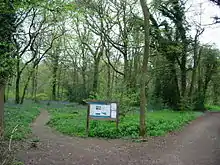 |
38.1 hectares (94 acres) |
Limpsfield 51.218°N 0.020°W TQ 412 485 |
Tandridge | NCR,[71] SSSI,[72] SWT[73] | Map | Details | This common on Weald Clay has been wooded since the Anglo-Saxon period and past management has left many ancient trees. The canopy is mainly pedunculate oak and the older trees support a rich lichen flora. The moth fauna is described by Natural England as outstanding, with six uncommon species.[74] |
| Stokes Field | .jpg.webp) |
5.9 hectares (15 acres) |
Long Ditton 51.379°N 0.325°W TQ 167 658 |
Elmbridge | Map | Details | The field has diverse habitats with a pond, scrub, woodland and grassland. Flora include crab apple trees, cuckoo flowers and pyramidal orchid.[75] | |
| West End Common |  |
70.3 hectares (174 acres) |
Esher 51.354°N 0.389°W TQ 123 629 |
Elmbridge | SSSI[29] | Map | Details | The common has wet areas, which have the rare flowering marsh plant starfruit, woodland with ancient oak and beech trees, and grassland. More than 2,000 species of insects have been recorded.[76] |
| Weybourne | 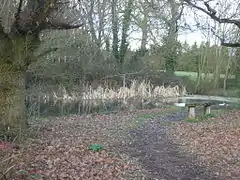 |
2.4 hectares (5.9 acres) |
Farnham 51.229°N 0.778°W SU 854 485 |
Waverley | Map | Details | This site has a variety of habitats, including woodland, grassland, fen and scrub.[77] | |
| White Rose Lane |  |
3.4 hectares (8.4 acres) |
Woking 51.309°N 0.544°W TQ 016 577 |
Woking | Map | Details | This site is damp alder woodland in two areas on the north bank of the Hoe Stream. There are several species of rare fungi and fauna include owls, bats, deer and frogs.[78] | |
| Whitmoor and Rickford Commons |  |
184.9 hectares (457 acres) |
Guildford 51.274°N 0.594°W SU 982 537 |
Guildford | SPA,[10] SSSI,[79] SWT[80] | Map | Details | This site on the heath of the London Basin has a variety of heathland habitats, as well as areas of woodland, meadow and still and running water. The heath has a nationally scarce spider Oxyopes heterophthalmus and beetle Hyperaspis pseudopustulata. There are also nationally important populations of several bird species.[81] |
Notes
- Details and area are on the 'Designated Sites View' pages on each site in the Natural England database of local nature reserves.[3]
- The location is taken from the Natural England details page for the site.
- The maps are on the Natural England database of local nature reserves.
- The link to the map of Rowhill Copse does not work. This is the link to the nearby Farnham Park, which also shows Rowhill Copse.
References
- "Protected or Designated Areas". Department for Environment, Food & Rural Affairs and Natural England. 9 April 2013. Archived from the original on 4 May 2015. Retrieved 29 July 2015.
- "Local Nature Reserves: Setting up and Management". Department for Environment, Food & Rural Affairs and Natural England. 2 October 2014. Archived from the original on 4 July 2015. Retrieved 29 July 2015.
- "Designated Sites View: Surrey". Natural England. Archived from the original on 18 October 2018. Retrieved 3 January 2019.
- "Surrey". Encyclopedia Britannica. Archived from the original on 3 October 2018. Retrieved 3 October 2018.
- "How is the population of Surrey changing?". Surrey County Council. Archived from the original on 3 October 2018. Retrieved 3 October 2018.
- "The County of Surrey". Visit Surrey. Retrieved 3 October 2018.
- "Ashtead Park". Register of Historic Parks and Gardens of Special Historic Interest in England. Historic England. Archived from the original on 23 November 2018. Retrieved 22 November 2018.
- "Ashtead Park". Surrey Wildlife Trust. Archived from the original on 24 October 2018. Retrieved 12 November 2018.
- "Designated Sites View: Thursley, Ash, Pirbright & Chobham". Special Areas of Conservation. Natural England. Archived from the original on 19 November 2018. Retrieved 28 September 2018.
- "Designated Sites View: Thames Basin Heaths". Special Protection Areas. Natural England. Archived from the original on 23 November 2018. Retrieved 28 September 2018.
- "Designated Sites View: Colony Bog and Bagshot Heath". Sites of Special Scientific Interest. Natural England. Archived from the original on 23 November 2018. Retrieved 6 November 2018.
- "Bisley & West End Commons and Reidon Hill". Surrey Wildlife Trust. Archived from the original on 24 October 2018. Retrieved 13 November 2018.
- "Blanchman's Farm". Local Nature Reserves. Natural England. Archived from the original on 18 October 2018. Retrieved 22 November 2018.
- "Designated Sites View: Blindley Heath". Sites of Special Scientific Interest. Natural England. Archived from the original on 4 November 2018. Retrieved 3 November 2018.
- "Blindley Heath". Surrey Wildlife Trust. Archived from the original on 24 October 2018. Retrieved 3 November 2018.
- "Blindley Heath citation" (PDF). Sites of Special Scientific Interest. Natural England. Archived (PDF) from the original on 3 October 2018. Retrieved 3 November 2018.
- "Brentmoor Heath and Folly Bog". Surrey Wildlife Trust. Archived from the original on 24 October 2018. Retrieved 6 November 2018.
- "Home page". Lingfield Nature Reserves. Archived from the original on 28 November 2018. Retrieved 25 November 2018.
- "Plan of reserves". Lingfield Nature Reserves. Archived from the original on 26 November 2018. Retrieved 25 November 2018.
- "Chertsey Meads". Local Nature Reserves. Natural England. Archived from the original on 18 October 2018. Retrieved 22 November 2018.
- "Chinthurst Hill Tower". Historic England. Archived from the original on 23 November 2018. Retrieved 22 November 2018.
- "Chinthurst Hill". Surrey Wildlife Trust. Archived from the original on 24 October 2018. Retrieved 13 November 2018.
- "Chinthurst Hill". Local Nature Reserves. Natural England. Archived from the original on 18 October 2018. Retrieved 22 November 2018.
- "Claygate Common". Local Nature Reserves. Natural England. Archived from the original on 18 October 2018. Retrieved 22 November 2018.
- "Earlswood Common". Local Nature Reserves. Natural England. Archived from the original on 18 October 2018. Retrieved 23 November 2018.
- "Edolph's Copse: Management Plan 2011–2016" (PDF). Woodland Trust. p. 6. Archived (PDF) from the original on 24 November 2018. Retrieved 23 November 2018.
- "Designated Sites View: Epsom and Ashtead Commons". Sites of Special Scientific Interest. Natural England. Archived from the original on 8 November 2018. Retrieved 14 November 2018.
- "Epsom Common". Local Nature Reserves. Natural England. Archived from the original on 18 October 2018. Retrieved 23 November 2018.
- "Designated Sites View: Esher Commons". Sites of Special Scientific Interest. Natural England. Archived from the original on 29 November 2018. Retrieved 7 November 2018.
- "West End Common". Local Nature Reserves. Natural England. Archived from the original on 18 October 2018. Retrieved 7 November 2018.
- "Farnham Park". Local Nature Reserves. Natural England. Archived from the original on 18 October 2018. Retrieved 24 November 2018.
- "Designated Sites View: Thursley, Hankley & Frensham Commons". Special Protection Areas. Natural England. Archived from the original on 19 November 2018. Retrieved 28 October 2018.
- "Designated Sites View: Thursley, Hankley & Frensham Commons". Sites of Special Scientific Interest. Natural England. Archived from the original on 24 November 2018. Retrieved 14 November 2018.
- "The Flashes". Local Nature Reserves. Natural England. Archived from the original on 18 October 2018. Retrieved 24 November 2018.
- "About". ox Corner Community Wildlife Area. Archived from the original on 25 November 2018. Retrieved 24 November 2018.
- "Flora & Fauna". ox Corner Community Wildlife Area. Archived from the original on 25 November 2018. Retrieved 24 November 2018.
- "Designated Sites View: Hackhurst and White Downs". Sites of Special Scientific Interest. Natural England. Archived from the original on 3 January 2019. Retrieved 13 November 2018.
- "Hackhurst Downs". Surrey Wildlife Trust. Archived from the original on 24 October 2018. Retrieved 8 November 2018.
- "Hill Park". Surrey Wildlife Trust. Archived from the original on 24 October 2018. Retrieved 13 November 2018.
- "Hill Park, Tatsfield". Local Nature Reserves. Natural England. Archived from the original on 18 October 2018. Retrieved 26 November 2018.
- "Hogsmill". Local Nature Reserves. Natural England. Archived from the original on 18 October 2018. Retrieved 26 November 2018.
- "Horton Country Park". Local Nature Reserves. Natural England. Archived from the original on 18 October 2018. Retrieved 26 November 2018.
- "Inholms Claypit". Surrey Wildlife Trust. Archived from the original on 24 October 2018. Retrieved 13 November 2018.
- "Lakeside Park". Local Nature Reserves. Natural England. Archived from the original on 18 October 2018. Retrieved 26 November 2018.
- "Mayford Meadows". Local Nature Reserves. Natural England. Archived from the original on 18 October 2018. Retrieved 26 November 2018.
- "Molesey Heath". Local Nature Reserves. Natural England. Archived from the original on 18 October 2018. Retrieved 26 November 2018.
- "Nore Hill Pinnacle". Local Nature Reserves. Natural England. Archived from the original on 18 October 2018. Retrieved 27 November 2018.
- "Designated Sites View: Ockham and Wisley Commons". Sites of Special Scientific Interest. Natural England. Archived from the original on 3 January 2019. Retrieved 14 November 2018.
- "Wisley & Ockham Commons & Chatley Heath". Surrey Wildlife Trust. Archived from the original on 24 October 2018. Retrieved 14 November 2018.
- "Ockham and Wisley Commons citation" (PDF). Sites of Special Scientific Interest. Natural England. Archived (PDF) from the original on 3 October 2018. Retrieved 14 November 2018.
- "Pewley Down". Local Nature Reserves. Natural England. Archived from the original on 18 October 2018. Retrieved 27 November 2018.
- "Scheduled Monuments in Surrey". Ancient Monuments. Archived from the original on 17 November 2018. Retrieved 16 November 2018.
- "Designated Sites View: Reigate Heath". Sites of Special Scientific Interest. Natural England. Archived from the original on 3 January 2019. Retrieved 14 November 2018.
- "Reigate Heat citation" (PDF). Sites of Special Scientific Interest. Natural England. Archived (PDF) from the original on 3 October 2018. Retrieved 16 November 2018.
- "River Mole". Local Nature Reserves. Natural England. Archived from the original on 18 October 2018. Retrieved 27 November 2018.
- "Map of River Mole". Local Nature Reserves. Natural England. Archived from the original on 12 December 2018. Retrieved 27 November 2018.
- "Riverside Park". Local Nature Reserves. Natural England. Archived from the original on 18 October 2018. Retrieved 28 November 2018.
- "Riverside Walk, Virginia Water". Local Nature Reserves. Natural England. Archived from the original on 18 October 2018. Retrieved 28 November 2018.
- "Rodborough Common". Surrey Wildlife Trust. Archived from the original on 24 October 2018. Retrieved 14 November 2018.
- "Rowhill Copse". Local Nature Reserves. Natural England. Archived from the original on 18 October 2018. Retrieved 31 December 2018.
- "Rowhill Nature Reserve". Rushmoor Borough Council. 11 October 2011. Archived from the original on 1 January 2019. Retrieved 31 December 2018.
- "Sayer's Croft". Local Nature Reserves. Natural England. Archived from the original on 18 October 2018. Retrieved 2 December 2018.
- "Mountain Wood (Quaternary of South-East England)". Geological Conservation Review. Joint Nature Conservation Committee. Archived from the original on 29 October 2018. Retrieved 28 October 2018.
- "Designated Sites View: Sheepleas". Sites of Special Scientific Interest. Natural England. Archived from the original on 3 January 2019. Retrieved 14 November 2018.
- "Sheepleas". Surrey Wildlife Trust. Archived from the original on 24 October 2018. Retrieved 14 November 2018.
- "Sheepleas citation" (PDF). Sites of Special Scientific Interest. Natural England. Archived (PDF) from the original on 3 October 2018. Retrieved 16 November 2018.
- "Designated Sites View: Combe Bottom". Sites of Special Scientific Interest. Natural England. Archived from the original on 3 January 2019. Retrieved 7 November 2018.
- "Shere Woodlands". Surrey Wildlife Trust. Archived from the original on 24 October 2018. Retrieved 7 November 2018.
- "Combe Bottom citation" (PDF). Sites of Special Scientific Interest. Natural England. Archived (PDF) from the original on 3 October 2018. Retrieved 7 November 2018.
- "Snaky Lane Community Wildlife Area". Local Nature Reserves. Natural England. Archived from the original on 18 October 2018. Retrieved 4 November 2018.
- Ratcliffe, p. 50
- "Designated Sites View: Staffhurst Wood". Sites of Special Scientific Interest. Natural England. Archived from the original on 3 January 2019. Retrieved 14 November 2018.
- "Staffhurst Wood". Surrey Wildlife Trust. Archived from the original on 24 October 2018. Retrieved 14 November 2018.
- "Staffhurst Wood citation" (PDF). Sites of Special Scientific Interest. Natural England. Archived (PDF) from the original on 3 October 2018. Retrieved 17 November 2018.
- "Stokes Field". Local Nature Reserves. Natural England. Archived from the original on 18 October 2018. Retrieved 28 November 2018.
- "West End Common". Local Nature Reserves. Natural England. Archived from the original on 18 October 2018. Retrieved 28 November 2018.
- "Weybourne". Local Nature Reserves. Natural England. Archived from the original on 18 October 2018. Retrieved 28 November 2018.
- "White Rose Lane". Local Nature Reserves. Natural England. Archived from the original on 18 October 2018. Retrieved 28 November 2018.
- "Designated Sites View: Whitmoor Common". Sites of Special Scientific Interest. Natural England. Archived from the original on 3 January 2019. Retrieved 14 November 2018.
- "Whitmoor & Rickford Commons". Surrey Wildlife Trust. Archived from the original on 21 June 2018. Retrieved 14 November 2018.
- "Whitmoor Common citation" (PDF). Sites of Special Scientific Interest. Natural England. Archived (PDF) from the original on 3 October 2018. Retrieved 21 November 2018.
Sources
- Ratcliffe, Derek, ed. (1977). A Nature Conservation Review. 2. Cambridge, UK: Cambridge University Press. ISBN 978-0-521-21403-2.